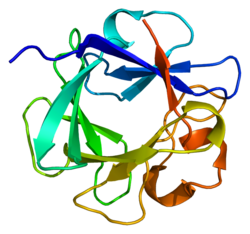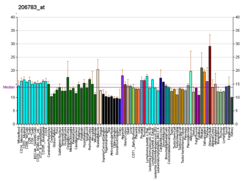Fibroblast growth factor 4 is a protein that in humans is encoded by the FGF4 gene.[5][6]
The protein encoded by this gene is a member of the fibroblast growth factor (FGF) family. FGF family members possess broad mitogenic and cell survival activities and are involved in a variety of biological processes including embryonic development, cell growth, morphogenesis, tissue repair, tumor growth and invasion. This gene was identified by its oncogenic transforming activity. This gene and FGF3, another oncogenic growth factor, are located closely on chromosome 11. Co-amplification of both genes was found in various kinds of human tumors. Studies on the mouse homolog suggested a function in bone morphogenesis and limb development through the sonic hedgehog (SHH) signaling pathway.[6]
- ^ a b c GRCh38: Ensembl release 89: ENSG00000075388 – Ensembl, May 2017
- ^ a b c GRCm38: Ensembl release 89: ENSMUSG00000050917 – Ensembl, May 2017
- ^ "Human PubMed Reference:". National Center for Biotechnology Information, U.S. National Library of Medicine.
- ^ "Mouse PubMed Reference:". National Center for Biotechnology Information, U.S. National Library of Medicine.
- ^ Galland F, Stefanova M, Lafage M, Birnbaum D (Jul 1992). "Localization of the 5' end of the MCF2 oncogene to human chromosome 15q15----q23". Cytogenetics and Cell Genetics. 60 (2): 114–6. doi:10.1159/000133316. PMID 1611909.
- ^ a b "Entrez Gene: FGF4 fibroblast growth factor 4 (heparin secretory transforming protein 1, Kaposi sarcoma oncogene)".





